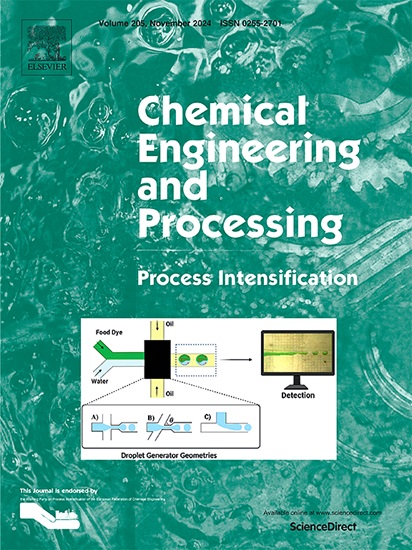Continuous flow wastewater induced plasma microbubbles for the enhancement of mass transfer and degradation of dye pollutants in a bubble column reactor
IF 3.8
3区 工程技术
Q3 ENERGY & FUELS
Chemical Engineering and Processing - Process Intensification
Pub Date : 2025-02-23
DOI:10.1016/j.cep.2025.110245
引用次数: 0
Abstract
To enhance the mass transfer and organic pollutants oxidation in the plasma bubble column reactor (BCR), a Venturi tube was utilized to produce flowing wastewater containing plasma microbubbles by hydrodynamic cavitation (HC) effect. Meanwhile, the convection of wastewater was optimized through adjusting Reynolds number at the throat of the Venturi tube (ReT: 5870 – 56,300). The variation of Cv and ΔP with the ReT revealed the starting point of the HC at the ReT of 24,600 (210 L·h-1). The HC effect reduced the minimum plasma bubble size d to 100 μm and increased the gas holdup of plasma bubbles (11 %). Comparing the plasma bubbling mode without liquid flow, energy yield (EY) of plasma degradation (2333 mg·kWh-1 at the removal of 90 %) and the volumetric mass transfer coefficient (kla = 0.037 s-1) was improved by 1.63 and 3.08 times, respectively. The dimensionless mass transfer correlation among Reynolds number Re (220 – 2113), Froude number Fr (0.0019 – 0.0075), initial concentration difference (c0/c50: 0.5 – 2.0), and Sherwood number Sh in the HC-BCR have been established. This study provides insights to optimize the convection of wastewater in the HC channel for the enhancement of plasma oxidation in the BCR.

求助全文
约1分钟内获得全文
求助全文
来源期刊
CiteScore
7.80
自引率
9.30%
发文量
408
审稿时长
49 days
期刊介绍:
Chemical Engineering and Processing: Process Intensification is intended for practicing researchers in industry and academia, working in the field of Process Engineering and related to the subject of Process Intensification.Articles published in the Journal demonstrate how novel discoveries, developments and theories in the field of Process Engineering and in particular Process Intensification may be used for analysis and design of innovative equipment and processing methods with substantially improved sustainability, efficiency and environmental performance.

 求助内容:
求助内容: 应助结果提醒方式:
应助结果提醒方式:


